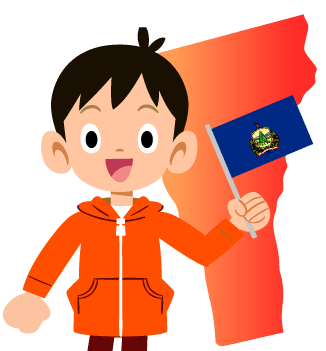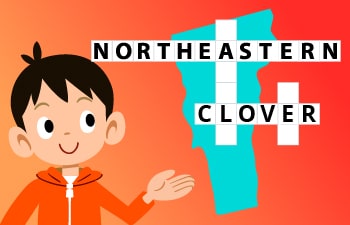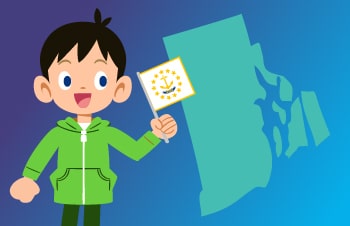Vermont got its name from two French words, “vert” meaning “green” and “mont” meaning “mountain.” Its nickname of the Green Mountain State is in honor of the Green Mountain Boys, who protected Vermont from New York and later served in the American Revolutionary, Civil, and Spanish American Wars.
Keep reading to learn more interesting facts about Vermont, including historical facts about Vermont, a Vermont history timeline, geography facts and more. Time4Learning members can download our list of PreK-12 interactive activities that align with your study of Vermont. Here are a few Vermont facts for kids:
Vermont Fast Facts
|
Became a Colony: |
1777 |
|---|---|
|
Became a State: |
March 4, 1791 |
|
Order it Joined the Union: |
14th state |
|
State Capital: |
Montpelier |
|
State Abbreviation: |
VT |
|
Border States: |
|
|
State Flag: |
|
|
State Song: |
|
|
State Flower: |
Red Clover |
|
State Nickname: |
|
|
Notable Vermonters: |
|
Historical Facts About Vermont
Vermont was one of the original 13 colonies of the United States, so Vermont’s history is important to the whole country. Native people lived in Vermont as far back as 13,000 years ago. When Samuel de Champlain arrived from France in 1609, he discovered a number of Native American tribes, including the Abenaki (who still live there today), Massachusett, Mohican, Pennacook, and Pocomtuc.
Colonial Vermont had an unsteady beginning. France had made the original claim on part of Vermont’s land and a permanent settlement on an island known as Isle La Motte in northern Lake Champlain. However, Great Britain established their first permanent settlement in 1724. Beginning in 1754, Great Britain and France fought for nine years, with Britain finally winning. King George III included Vermont as part of New York, but Vermont declared itself as an independent colony in 1777.
Conflict continued as New York continued to oppose Vermont’s independence and the Continental Congress refused to acknowledge Vermont as independent. Vermont continued to function as independent from the union even after the end of the Revolution, having its own constitution, president, currency, and even postal service. It continued negotiations and actions until New York finally gave up all claims to Vermont lands in 1790. Vermont then became the 14th state in 1791.
Now that you have the gist, read the Vermont history timeline below to learn detailed historical facts about Vermont.
1535
French explorer Jacques Cartier is the first European to see the Vermont area1609
French explorer Samuel de Champlain arrived in Vermont1724
British established their first permanent settlement at Fort Drummer1754
French and Indian War began between Britain and France over lands including Vermont1763
French and Indian War ended, with Britain gaining control of Vermont and including it as part of New York1775
American Revolutionary War began with the Green Mountain Boys’ assault on Fort Ticonderoga as one of the first offensive actions by American forces1777
Vermont declared itself an independent colony, with the capital shifting across the Green Mountains each time the General Assembly met (known as “mountain rule”)1790
New York gave up its claims to Vermont1791
Vermont became the 14th state in the US, under President George Washington1805
Montpelier became the capital1861
American Civil War began, with Vermont fighting on the side of the UnionBring history and geography to life with Time4Learning’s interactive online social studies curriculum for grades 2-12.
Vermont Geography Facts
Now you have some Vermont history facts down, let’s turn our attention to the state’s geography. Much of the state, almost 80 percent, is forested. The sugar maple (state tree) is the source of Vermont’s famous maple syrup, but there are other common trees such as cedar, spruce, pine, and yellow birch.
Also decorating Vermont are many wildflowers including sweet white violets, pink fairies, wild bleeding hearts, and bulbous buttercups. Vermont’s wildlife consists of moose, black bears, white-tailed deer, red foxes, martens, and fishers, along with its peregrine falcons, ospreys, barred owls, ruffed grouse, eastern bluebirds, and American robins.
Closer to the ground you will find red-bellied snakes, common five-lined skinks, snapping turtles, mudpuppies, and American bullfrogs. Examine this map of Vermont to find out the basic geography of the state. Then read through the following Vermont geography facts. Print out the map of Vermont provided below and add these items to the map.
- Vermont is bordered by Canada in the north, Massachusetts in the south, New York in the west, and New Hampshire in the east.
- The capital, Montpelier, lies in the center of the northern half of the state.
- Lake Champlain forms the northern half of the border with New York.
- The Connecticut River forms the border with New Hampshire.
- The Green Mountain Range formed over 400 million years ago and is found in the center of the state.
- The Taconic Mountains are found in southwestern Vermont.
- Vermont’s highest point is Mount Mansfield, at 4,393 feet above sea level, in the Green Mountain Range.
- The lowest point is Lake Champlain at 95 feet above sea level.
Vermont State Map
Download our FREE Vermont state map printable. Use it as a coloring page or use it to plot the state’s geographical features.
Activities for Children in Vermont
What is the next step to learning fun facts about Vermont? If you can, visit the state to see some of its unique places. Homeschoolers in Vermont might have it easier for travel, but both locals and out-of-state homeschoolers need to plan. Here are a few ideas to help you learn some Vermont state facts:
- Billings Farm & Museum (Woodstock): Visit the 1890 farmhouse and working dairy farm. Meet the Jersey dairy cows, sheep, and draft horses, and even taste some fresh cheeses. Experience the educational exhibits and interactive activities, programs, and events. View the short film documentary of the estate and learn to milk a cow! Watch for homeschool art classes or organize a Homeschool Days group visit.
- Montshire Museum of Science (Norwich): Explore over 150 science exhibits, including those examining bubbles, air, life in local waters, fog, bees, elements of glass, the science of musical instruments, and more. Outside, enjoy miles of trails with views of the Connecticut River, exhibits about the Upper Connecticut River Valley, and outdoor water exhibits. Take a Planet Walk for a scale-journey from Pluto to the sun. Check the calendar for Homeschoolers Days and Series or organize a homeschool group or family visit.
- President Calvin Coolidge State Historic Site (Plymouth): Explore the visitor center for the Calvin Coolidge Homestead District, a national historic landmark. See the farmhouse and sitting room where our 30th president took the oath of office hours after the death of President Harding. Discover the post office, general store, restaurant, church, several barns containing the farming tools of the period, and a dance hall that was the summer white house office. Tour the Plymouth Cheese Factory, founded by the president’s father, and sample the cheese.
- Shelburne Museum (Shelburne): Learn about Vermont’s history, art, and natural beauty in the 39 buildings that are part of this museum. See examples of New England architecture as you browse four centuries of fine and decorative arts, textiles, toys, folk art, carriages, decoys, and many other artifacts of Americana. Admire horse-drawn carriages and Vermont firearms. Enjoy the carousel and circus building, steamboat, and children’s art and activity centers. Check the calendar for special events, daily activities, and camps.
- Vermont Institute of Natural Science Nature Center (Quechee): Visit this 47-acre campus housing raptor enclosures, exhibits, classrooms, nature trails, and a forest canopy walk. Stay for scheduled programs like reptile encounters and live bird programs. If you cannot visit, consider renting a teaching kit for your homeschool.
Looking for more things to do with your kids in Vermont? Check out this post full of field trip ideas in Vermont!
Vermont Freebies and Deals for Homeschoolers
- Marsh-Billings-Rockefeller National Historical Park (Woodstock): Explore Vermont’s only national park with its forests, hiking trails, and programs. Learn about the women of the estate or Victorian-era superstitions or view the artwork focused on conservation. While there is a cost for guided tours of the mansion for adults, children ages 15 and under are free. Admission to the park is always free, and there are free guided tours of the mansion on national fee free days.
- Morse Farm Maple Sugarworks (Montpelier): Visit this outdoor farm life museum to appreciate the product that has made Vermont famous. Take a tour of the sugar house, view the multimedia displays in the woodshed theater, explore the nature trail, and browse the country store. Interact and photograph the carved folklife characters. Admission is free.
- Old First Congregational Church (Bennington): Visit this Protestant church that was organized in 1762, with a meeting house built in 1763 and the present church built in 1805. It was the first church in Vermont signifying the separation of church and state. See the graves of the poet Robert Frost and many Revolutionary war heroes. Admission is free.
- Vermont State House (Montpelier): Witness one of the oldest and best-preserved state capitals in the US located in the smallest capital city, Montpelier. Take a guided or self-guided tour or check out an audio tour wand. Observe activities in the chambers and committee rooms. Admission is free, as are most of the tours. A virtual tour is available on the website for those who cannot visit.
Vermont Learning Games for Children
How many interesting things about Vermont do you know? Test your knowledge of Vermont facts for students with these free games and activities:













